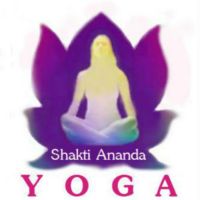 The Twelve Basic Asanas
The Twelve Basic Asanas
Shaktiananda Yoga follows the Rishikesh tradition of Patanjali; taught by Swami Sivananda, then taught by his disciple Swami Vishnu-devananda. And now taught by Swami Shri Mahashaktiananda. Our daily practice is based around twelve basic postures which constitute the essence of all asanas. Of course we also practice many more in addition to these. An illustrated example of the twelve basic asanas are above.
“I am grateful to my teacher Swami Sivananda for his instruction in Hatha Yoga. For each of the asanas listed below, there are detailed instructions which are provided by the Advaita Yoga Ashrama. The twelve basic asanas include the sirshasan (headstand), which should only be practiced for a couple of minutes at a time. This inverted posture places alot of pressure on the head and fine nerves in the brain. Only attempt to practice this posture if you are in very good health. In fact, it is not necessary to practice the headstand at all.”
~Gurudevi, Shri Mahashaktiananda
Sirshasan (Headstand) – view instructions
Sarvangasan (Shoulderstand) – view instructions
Halasan (Plough Pose) – view instructions
Matsyasan (Fish Pose) – view instructions
Paschimotthan (Inclined Plane – Head-Knee Pose) – view instructions
Bhujangasan (Cobra Pose) – view instructions
Salabhasana (Locust Pose) – view instructions
Dhanurasana (Bow Pose) – view instructions
Ardha Matsyendrasana (Spinal Twist) – view instructions
Kakasana (Crow Pose) – instructions or Peacock – (Mayurasana) – instructions
Padahastasana (Hands to Feet) – view instructions
Trikonasana (Triangle Pose) – view instructions
Savasana (Final Relaxation)
Closing Dhyana Slokas (Audio of Mantras – Om Tryambakam)
Text for Dhyana Slokas (Hatha Yoga Mantras see below)
*Note: These Mantras are called Dhyana Slokas (meditation verses or Gajananam for short.)
The audio is provided by the Advaita Yoga Ashrama
Hatha Yoga
Tuning in the Mind
At the beginning of each yoga class, in order to raise the room’s energy as well as to relax, focus and uplift our mind, we recite some mantras. These mantras come from the ancient, sacred sanskrit language of Sanskrit. Through their repetition we invoke the spiritual powers of the following deities: Ganesha, Subramanya, Saraswati, the Guru, and Durga Devi.
-
The Ganesha mantras are recited at the beginning of any undertaking and give the energy to start something and to overcome obstacles of all kinds – internal and external
-
The Subramanya mantras give us the energy to sustain our efforts and practice and to overcome the lower tendencies of our mind: laziness, jealousy etc.
-
Through Her mantras, the goddess Saraswati bestows knowledge and helps us tap into the deep reservoir of spiritual knowledge as we practice.
-
It is an ancient and pivotal tradition in yoga to invoke our Guru and the lineage of all masters who came before us at the beginning of the practice. Invoking their blessings will help connect with the vibrant spiritual experiences that they have achieved. This is the primary reason why yoga is so alive after having been transmitted from teacher to student for several millenia. At the Advaita Yoga Ashrama, we invoke the two great masters: Swami Sivananda and Swami Vishnu-devananda.
-
Last, but not least, is the prayer to Durga, the Divine Mother, who represents the ultimate power (sakti) of the universe.
Opening Mantras
Audio for these in music Gajananam
provided by the Advaita Yoga Ashrama
Dhyana Slokas
These mantras are called Dhyana Slokas (meditation verses) or Gajananam for short.
Om. Om. Om.
Gajananam Bhutaganadi Sevitam
Kapitta Jambu Phala Sara Bhakshitam
Uma Sutam Shokavinasha Karanam
Namami Vigneshvara Pada Pankajam
Shadananam Kunkuma Raktavarnam
Mahamatim Divya Mayura Vahanam
Rudrasya Sunum Surasainya Natham
Guham Sadaham Sharanam Prapadye
Ya Kundendu Tushara Hara Dhavala
Ya Shubra Vastravrita
Ya Vina Varadanda mantita Kara
Ya Sveta Padmasana
Ya Brahmaachyuta Sankara Prabhitibhir
Devai Sada Pujita
Sa Mam Patu Sarasvati Bhagavati
Nishyesha Jatyapaha
Om Namah Sivaya Gurave
Sat Chid Ananda Murtaye
Nisprapanchaya Shantaya
Sivanandaya Te Namaha
Sri Vishnu Devanandaya Te Namaha
Om Sarva Mangala Mangalye
Shive Sarvatha Sadhike
Sharanye Tryambake Gauri
Naraayani Namostute
Naraayani Namostute
Om Shantih Shantih Shantih

